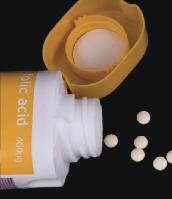News, views and insights on maintaining a healthy edge.
 California Cool
California Cool
Revenge is a dish best served cold. But if scientists at the University of Southern California are right, soon the target of that revenge might not feel it. That’s because neurobiology professor David McKemy and his team have isolated the sensory network of neurons in the skin that relays the sensation of cold to the brain. The USC researchers reported in the February Journal of Neuroscience that they have managed to control TRPM8 (pronounced tripemate)—the sensor of cold temperatures, and also menthol—to “turn off” cold receptors in the skin, without turning off the heat receptors. Their discovery has promising implications in the treatment of pain. “One of our goals,” says Dr. McKemy, “is to pave the way for medications that address the pain directly, in a way that does not leave patients completely numb.”
 Drop-Dead Good, Y’all
Drop-Dead Good, Y’all
Earlier this year, at the American Stroke Association’s international conference, research was presented confirming what everyone knows but we’re all too willing to ignore: A diet of Southern-style foods is directly linked to a higher risk of stroke. That diet—characterized by researchers as including fried chicken, fried fish, fried potatoes, bacon, ham, liver, gizzards and sugary drinks—explains why, statistically speaking, Southerners are 20 percent more likely to suffer a stroke than the rest of Americans. “We’ve got three major factors working together in the Southern-style diet to raise risks of cardiovascular disease,” explains lead researcher Dr. Suzanne Judd, a nutritional epidemiologist at the University of Alabama-Birmingham. “Fatty foods are high in cholesterol, sugary drinks are linked to diabetes and salty foods lead to high blood pressure.” This was the first large-scale study on the relationship between down-home cooking and stroke events.
 Link Between Folic Acid and Autism
Link Between Folic Acid and Autism
Obstetricians have been recommending folic acid for their patients for decades. Results of a Norwegian study published in the Journal of The American Medical Association provides expecting moms with one more good reason to listen to their baby doctors. Women who took folic acid supplements from four weeks before conception to eight weeks after had a 40 percent lower chance of having an autistic child. Researchers looked for correlations between other supplements and diets—and also explored the affect of folic acid on Asberger Syndrome—but did not find anything of statistical significance. Interestingly, pregnant women who took folic acid beyond the eighth week of pregnancy showed no marked improvement over those who took it for only the first eight weeks. “This vitamin is also known to decrease the risk of neural tube defects to the developing baby,” adds Dr. Orli Langermost, Director of Obstetrics and Perinatal Services at Trinitas. “The Norwegian study reports a lower risk of autism amongst mothers who took folic acid supplements before and during early pregnancy. Although more research is needed to investigate whether this association is causal, it is another great reason for obstetricians to promote prenatal folic acid supplementation to their pregnant patients.” The article was careful to point out that this study does not prove that folic acid supplements can prevent childhood autism. However, the findings are so apparent that they constitute a good argument for further exploration.
 The Slim Jim Diet
The Slim Jim Diet
No, you can’t lose weight eating Slim Jims. But the nitrite-packed meatsticks (that is meat, right?) aren’t as bad for you as you think. You might be surprised to know that fruits, vegetables and your own saliva also contain nitrites. So what gives? The idea that nitrites cause cancer stems from two reports (one in Nature and another in Science) issued in the 1970s, which created a media sensation and triggered a cascade of food-additive legislation. In 2012, Dr. Andrew Milkowski of the Food Research Institute at the University of Wisconsin-Madison, authored a study that attempted to put the threat of nitrites into better context. The Science article, he says, “was later found to be flawed—but that was not nearly as well-publicized.” Dr. Milkowski also points out that the human body makes 70 to 100 milligrams of nitrite per day. By contrast, a cooked hotdog, a side order of bacon or a Slim Jim has only a few milligrams of nitrite left in it (if that). In other words, you’d have to eat 30 or 40 Slim Jims to take in the same amount of nitrites you get swallowing your own spit every day. Bon appétit!
 Oils Well that Ends Well?
Oils Well that Ends Well?
Not all polyunsaturated vegetable oils are created equal. According to the results of the Sydney Diet Heart Study, which monitored 458 Australian men—aged 30 to 59—with a history of cardiovascular problems, oils containing Omega-6 fatty acid did not live up to their long-touted health benefits. On the contrary, the study found that participants who consumed vegetable oils rich in Omega-6 (in the form of safflower oil and safflower oil polyunsaturated margarine), actually had an elevated risk of death from all causes—including death due to coronary heart disease and cardiovascular disease. Some scientists are now saying that the American Heart Association’s recommendation that people get more Omega-6 fatty acid may need to be revisited. “People just ran with s the ball that polyunsaturates are good for you, so therefore each individual one must be good for you,” says Richard Bazinet, a nutrition professor at the University of Toronto. “That turns out not to be true.” Omega-6 oils include safflower and corn oil. Omega-3 oils, which lived up to their billing as “heart-healthy” in the Australian study, include canola oil, and oil from flaxseed, walnuts and fish such as salmon and trout. Soybean oil contains both Omega-3 and Omega-6. Michelle Ali, RD, Director of Food & Nutrition Services at Trinitas, points out that while this study finds that polyunsaturated fatty acid (PUFA) or specifically, safflower oil, was not as beneficial—and may be detrimental to those with heart disease—she doesn’t believe that the message presented by the American Heart Association (AHA) is completely wrong. “Since October 2000, the AHA has placed more emphasis on foods rather than on percentage of food components, such as fat, cholesterol, etc.,” she explains. “However, as the science evolves we will find that changes will have to be made and the public educated.”





